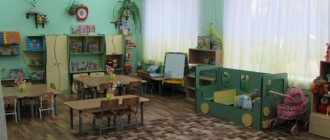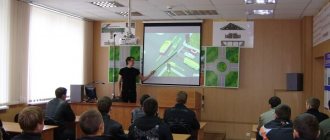MAGAZINE Preschooler.RF
Report “Requirements for organizing a speech corner in a group of preschool educational institutions”In modern preschool education, speech is considered as one of the foundations of raising and educating children, since the level of speech determines the success of children’s education at school, the ability to communicate with people and general intellectual development. The developmental environment and communication are factors that determine speech development. Today we will look at one of the centers of the subject-development environment - the Speech Corner. It is a specially equipped space for playing alone or in small groups.
The purpose of the speech corner: to promote the creation of optimal conditions for organizing a subject-development environment in a group to improve the process of development and correction of children’s speech.
Tasks:
- Formation of phonemic perception and hearing.
- Development of articulatory motor skills.
- Strengthening the skills of correct pronunciation of sounds.
- Consolidation of skills acquired in classes.
- Activation of vocabulary, generalizing concepts and lexical and grammatical categories.
- Development of coherent speech.
- Development of fine motor skills.
Its equipment includes shelving located at different levels, a table, a chair, gaming, didactic and visual material that stimulates speech activity and verbal communication in children.
When selecting the components of a speech corner, it is necessary to take into account:
- correspond to the individual and age characteristics of children;
- the speech corner should be placed next to the book corner;
- It is important that the speech corner is comfortable and aesthetically pleasing. Beauty shapes a child. Therefore, it is necessary to pay great attention to the aesthetics of the speech corner. Its design should be attractive to children and arouse their desire for independent activity. At the same time, it is necessary to teach children to maintain order and cultivate a caring attitude towards materials and equipment contained in the corner;
- gaming material must be accessible to the child;
- An integral attribute of the speech corner should be a toy - an “animate character” , an ordinary doll, a bi-ba-bo, a puppet. Such a toy should be multifunctional. She can move (with the help of an adult or child), perform articulation exercises, ask or answer questions, ask riddles, come up with interesting stories, present unexpected surprises and much more. Her abilities will arouse keen interest in children and encourage speech activity.
- Do not overload the corner with equipment.
The speech corner is based on gaming and didactic material aimed at developing:
articulatory motor skills (object support pictures; articulatory patterns; articulatory gymnastics in albums for a specific sound; articulatory gymnastics in poetry and pictures; cotton swabs, cotton pads)
aids for the development of breathing (colorful balls; plumes; paper snowflakes; pinwheels - pencils; foil bells on a string, etc.)
aids for the development of fine motor skills (dry pool; massage rollers, balls, clothespins, stencils; finger games; various materials for composing letters)
material on onomatopoeia (noise instruments; sound boxes; children's musical instruments: piano, accordion, drums, pipe, tambourine, rattle, bells, rattles; subject, plot pictures for expressing sounds and their automation; sounds of vowels and consonants (houses for hard and soft sounds); individual manuals for sound-letter analysis; word diagrams; sound tracks, sound ladder; albums on the syllabic structure of words)
games and aids for automating sounds (small toys; object pictures; plot pictures; various types of theaters; albums for each sound; speech therapy albums for automating various sounds; tongue twisters, poems, nursery rhymes, tongue twisters; sound characteristics diagram; word diagram)
games on vocabulary and grammar (subject pictures on lexical topics)
games for the development of coherent speech (series of plot pictures; different types of theater; tongue-twisters, poems, nursery rhymes, tongue twisters; library of children's books, etc.)
literacy materials - (magnetic board; sets of magnetic letters; cash registers of letters and syllables; cubes “ABC in pictures” , “Learn to read” , “Smart cubes” , “Syllable cubes” ).
The content of the speech corner is determined not by chance, but in strict accordance with the program, physiological and psychological characteristics of the formation of children’s speech.
The selection of gaming and didactic material is carried out jointly by the speech therapist and educator, which makes their interaction not formal, but very close and fruitful.
Requirements for the content of speech centers in different age groups
Junior group
- Book corner 5-6 titles of books, 2-5 copies each, since children of this age are characterized by imitation, screen books (we select books taking into account the age of the children, namely, for this age, works of Russian folklore: ditties, nursery rhymes, songs, folk tales about animals, works of Russian and foreign classics, stories, fairy tales, poems by modern authors);
- Albums or illustrations on the topics “Toys” . “Family, “Transport” , “Pets” , “Clothing” , “Dishes” , “Furniture” .
- Pictures with simple plots and actions
- Didactic games for the formation of vocabulary, vocabulary, grammatical structure of speech, coherent speech.
- Didactic games for grouping, classification, series like “What’s extra?” , . ”
- Games like “Find a pair” , “Find the differences” .
- Game visualizers, toys - phones.
- Games with object pictures like “What has changed?”
- Pictures with a simple plot for writing stories.
- Albums of riddles, tongue twisters, songs, nursery rhymes, poems.
- Stencils, templates.
- Games for developing manual skills.
- Card index of speech games.
- Postcards about your hometown.
Middle group
- Book corner: 5-6 titles, for decoration you can use prints on the themes of Russian folk tales. Once a quarter it is necessary to organize thematic exhibitions “Fairy Tales” , “Seasons” , “Tales of Animal Friendship” , etc.
- The albums are supplemented by topics about the Russian army, the work of adults, wild animals, flowers, vegetables, fruits, and the seasons about various buildings (architecture).
- Postcards for viewing.
- Portraits of writers according to the program
- Didactic games for grouping, classification, series like “What’s extra?” , . ”
- Fable games “What in the world doesn’t happen?” , "Who's screaming?"
- Games with pictures - riddles and subject pictures like “What has changed?” "Find a match?" , "Find differences" .
- Didactic games for the formation of vocabulary, vocabulary, grammatical structure of speech, coherent speech.
- Game visualizers, phone toys, entertaining puzzles.
- Albums of riddles, tongue twisters, tongue twisters, poems.
- Stencils, templates for preparing your hand for writing
- Games to develop manual skills.
- Card index of verbal speech games.
- Postcards about your hometown, region.
- Household and antique items.
Senior group
- Book corner 7-8 books of various subjects and genres (maybe books of the same title, but illustrated by different artists). Once a quarter, thematic exhibitions with children’s drawings on a given topic are organized
- Portraits of writers according to the program
- Albums or illustrations are supplemented with information about the Motherland and technology.
- Books based on children's drawings on themes from works by children's writers.
- Portraits of artists - illustrators.
- Didactic games for the formation of vocabulary, vocabulary, grammatical structure of speech, coherent speech, in preparation for learning to read and write.
- Games - fables, games - pictures like “Name the differences” .
- Sets of pictures “Make a story from the picture” , “Put them in order and make a story” .
- ABC of letters of different textures.
- Albums of riddles, tongue twisters, tongue twisters, poems.
- Stencils, punched cards, templates for preparing your hand for writing
- Games to develop manual skills.
- Card index of verbal speech games.
- Collection of badges, stamps, calendars, labels.
- Didactic material for depicting letters (ropes, laces, wire, pebbles, sand, plasticine, etc.).
- Blanks for shading, coding, stencils, punched cards.
- Sets of letters of different colors, sizes, materials, sound rulers, syllabic rulers.
- Illustrations about monuments and museums of antiquity (Moscow, St. Petersburg).
- Map of Russia, where cities are marked with flags.
Preparatory group for school
- Availability of a library of books by section: about nature, about animals or by author. 10-12 books are exhibited, varying in genre and subject matter. Thematic exhibitions with children's drawings are organized.
- Albums or material about the work and life of writers.
- Albums of riddles, tongue twisters, poems.
- Blanks for shading, coding, stencils, punched cards for preparing the hand for writing, games for developing manual skills.
- Card index of verbal speech games.
- Collection of badges, stamps, calendars, labels.
- Didactic material for depicting letters (ropes, laces, wire, pebbles, sand, plasticine, etc.).
- Sets of letters of different colors, sizes, materials, sound rulers, alphabet letters of different textures.
- Didactic games for the formation of vocabulary, vocabulary, grammatical structure of speech, teaching children to read and write.
- Games - fables “What did the artist mix up?” , games - pictures like “Find the differences” .
- Sets of pictures “Make a story from the picture” , “Put them in order and make a story” .
- Albums or books are homemade with children’s creations and drawings.
- Corner “Read ourselves” magazines “Fidget” , “Funny Pictures” , “Sunny Bunny” , etc., children's colorful books with large print, books with educational tasks.
| Next > |
Speech corner in the middle group
Yana Aleksandrovna Khasanova
Speech corner in the middle group
In modern preschool education, speech is considered as one of the foundations of raising and educating children, since the success of children’s education at school, the ability to communicate with people and general intellectual development depend on the level of mastery of coherent speech. The development of speech and verbal communication is carried out in all types of children's activities, in different forms. The developmental environment and communication are factors that determine speech development.
The subject-development environment is important for the development of young children who do not yet read, especially in their independent activities. A favorable speech environment develops where there is great interest in books, in reading, where intellectual needs arise and are satisfied.
The Speech Development Center was created with the goal of comprehensive development of the speech of our students.
The center includes and helps solve the following tasks:
Development of articulatory motor skills: object pictures-supports; articulation patterns; articulatory gymnastics in albums for a specific sound; articulatory gymnastics in poems and pictures.
Development of speech breathing: Consolidating correct speech exhalation and developing the ability to control the strength and duration of the air stream.
A card index of games, a set of breathing exercises, examples of games: “Blow a snowflake off your mitten”, “Hot tea”, “Butterfly, fly!”, “Whose bird will fly farther”.
Development of fine motor skills: Finger gymnastics using poems, songs, nursery rhymes; Massage with rubbing fingers and hand massagers; Folk games with palms; Games with natural materials; Games with household items; Strings; clothespins; beads, laces...
For many themed games, a sensory box
.Fine motor skills, tactile sensations, coherent speech, imagination, and fantasy develop. The kids love playing out their sand fairy tales in this “box.”
Work on the grammatical structure of speech: teaching various methods of word formation, forming grammatically correct speech.
Replenishing vocabulary: Activating vocabulary, general concepts and lexical and grammatical categories. Subject pictures on lexical topics; “Big and small” (used in a diminutive form) “What is made of what”; "Weather forecast"; "Transport"; “In the world of animals”, etc.
The speech corner is located next to the book corner: Working in this corner contributes to the development of all aspects of the speech system: enriching vocabulary, the ability to correctly construct a statement, retell a text, write descriptive and creative stories.
Let's play theater: For the purpose of speech development and the development of the emotional sphere of preschoolers, a theater corner with different types of theater has been created in the group. In the dramatization of fairy tales, children learn to construct sentences correctly, transform into different characters, while changing their intonation and voice.
Recognition of non-speech sounds: Games: “Silence”, “Guess what I’m playing on”, “Recognize by sound”, “Noise bags”, “Quiet-loud” and others. They promote the development of auditory memory and auditory attention, without which it is impossible to teach a child to listen to the speech of others and differentiate phonemes. At this time, physical hearing works.
I wish you all success in your professional activities!
Slide captions:
Equipping a speech corner in accordance with the Federal State Educational Standard in the second junior group. Nikiforova A.O. Group No. 13
1.Formation of vocabulary 1. Based on enriching ideas about the immediate environment, continue to expand and activate children’s vocabulary. 2. Clarify the names and purposes of items of clothing, shoes, hats, dishes, furniture, and types of transport. 3. Develop the ability to distinguish and name essential details and parts of objects (for a dress - sleeves, collar, pockets, buttons), qualities (color and its shades, shape, size), surface features (smooth, fluffy, rough), some materials and their properties (paper easily tears and gets wet, glass objects break, rubber toys restore their original shape after being compressed), location (outside the window, high, far away, under the cabinet). 4. Draw children’s attention to some objects that are similar in purpose (plate - saucer, chair - stool, fur coat - coat - sheepskin coat). 5. Develop the ability to understand general words (clothing, dishes, furniture, vegetables, fruits, birds, etc.); name the parts of the day (morning, afternoon, evening, night); name domestic animals and their babies, vegetables and fruits. Objectives of speech development in accordance with the requirements of the modern Federal State Educational Standard:
2. Formation of sound culture of speech 1. Improve children’s ability to clearly pronounce vowels in words (a, u, i, o, e) and some consonant sounds (p - b - t - d - k - g; f - v; t - s - z - c). 2. Develop motor skills of the speech-motor apparatus, auditory perception, speech hearing and speech breathing, clarify and consolidate the articulation of sounds. 3. Develop the correct tempo of speech and intonation expressiveness. 4. Develop the ability to clearly pronounce words and short phrases, speak calmly, with natural intonations.
3. Formation of the grammatical structure of speech 1. Improve children’s ability to coordinate adjectives with nouns in gender, number, case; use nouns with prepositions (in, on, under, for, about). 2. Help to use in speech nouns in singular and plural form, denoting animals and their young (duck - duckling - ducklings); the plural form of nouns in the genitive case (ribbons, nesting dolls, books, pears, plums). Treat children's word creation as a stage of active mastery of grammar, prompt them to the correct form of the word. 3. Help children obtain common ones from common simple sentences (consisting only of a subject and predicate) by introducing definitions, additions, and circumstances into them; make sentences with homogeneous members (“We will go to the zoo and see an elephant, a zebra and tigers”).
4. Formation of coherent speech 1. Develop a dialogical form of speech. Involve children in conversation while looking at objects, paintings, illustrations; observations of living objects; after watching performances and cartoons. Develop the ability to conduct a dialogue with the teacher: listen and understand the question asked, answer it clearly, speak at a normal pace, without interrupting the adult speaking. Remind children of the need to say “thank you”, “hello”, “goodbye”, “good night” (in the family, group). 2. Develop children’s proactive speech in interactions with adults and other children. In order to develop initiative speech, enrich and clarify ideas about objects in the immediate environment, provide children with pictures, books, and sets of objects for independent examination.
It is advisable to place the speech corner next to the book corner. The design of the corner should be aesthetic. Game material must be accessible to the child. Do not overload the corner with equipment. An integral attribute of the speech corner should be a toy - an “animate character”. When organizing a speech corner, the following requirements must be observed:
We use material from the corner of knowledge: D didactic games to develop the ability to distinguish and name essential details and parts of objects (for a dress - sleeves, collar, pockets, buttons), qualities (color and its shades, shape, size), surface features (smooth, fluffy, rough), some materials and their properties (paper easily tears and gets wet, glass objects break, rubber toys restore their original shape after being compressed), location (outside the window, high, far away, under the closet). freshwater”, etc. 1. Formation of a dictionary
2.Sound culture of speech
Grammatical structure of speech Connected speech
Thank you for your attention!





